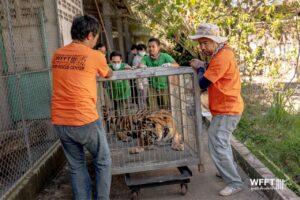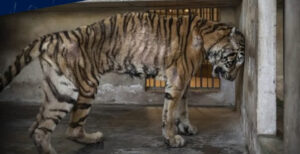This post was originally published on Sustainability Times
Source: Sustainability Times
A picture is worth a thousand words, the saying goes, and this one certainly does. In it a badly emaciated female tiger called Salamas, her ribcage visible through furless skin, stands on wobbly legs with her eyes closed and her head held against the concrete wall of its small cage.
This picture of utter misery was taken by wildlife rescuers in Thailand who have just saved 12 tigers and three leopards from near-certain death from a so-called tiger farm in the northern part of the country. The operation was spearheaded by Wildlife Friends Foundation Thailand (WFFT) after suspicions arose that the unnamed facility had been engaging in the illegal trafficking of wildlife.
“Veterinary teams and wildlife experts from WFFT were on hand to rescue the seized animals in the first part of the largest tiger rescue operation by an NGO in Thailand’s history. We are hopeful that 35 tigers in total will eventually be rescued from the farm,” the non-profit explains.
It goes on to add that the first 15 animals to be rescued were chosen on the basis of their condition with a priority given to those in the worst shape.
“Emaciated, elderly tiger Salamas was among the first to be rescued. While most other tigers were sedated so that they could safely be moved into transport cages, Salamas’s worrying condition meant that the veterinary team advised against this due to the risk of her not waking up from the sedation,” the non-profit says.
“Our rescue team instead spent hours gently encouraging the twenty-year-old tiger with food so that she would walk from her concrete enclosure into the transport cage. It was feared that she was too weak to walk, but eventually she gathered her strength and stumbled over to the cage,” WFFT writes.
“She was then able to be lifted to the specialist wildlife ambulance that made the twelve hour overnight drive to the wildlife rescue sanctuary. Although alarmingly skinny and with huge patches of fur missing across her body, rescuers are hopeful that Salamas will now begin to recover,” the NGO continues.

Farms like this are common around Thailand and other nations in the region where tigers are bred for their body parts for use in traditional Chinese medicine, which has long been a scourge on wildlife, particularly critically endangered animals highly prized by practitioners, including tigers, rhinos and pangolins, which are being driven extinct as a result. The iconic predators have also been widely used as props for pictures with tourists in petting zoo-like settings.
Indicating the extent of the plight of tigers not only in Thailand but throughout their remaining ranges in Asia is that there are far more of them in captivity than in the wild. And many of those in captivity are kept in dire conditions and subjected to what in effect amounts to torture. This certainly has been the case at the facility in northern Thailand.
“These animals have been kept in small, concrete enclosures for their entire lives, with many of them spending over twenty years in captivity. It is therefore believed that their new sanctuary home at WFFT will be the first time that many of these animals will have felt grass beneath their paws and sunlight on their fur,” the Thailand-based animal charity notes.
“The rescue tigers and leopards will now receive urgent medical care at our Wildlife Hospital. Sadly, they will never be able to return to the wild, but we can offer them the next best thing: a safe, sanctuary home where they can roam forested land, socialise with other tigers, and swim in the lake.”
The post An NGO saves 15 big cats from certain death at a tiger farm in Thailand appeared first on Sustainability Times.




0 Comments